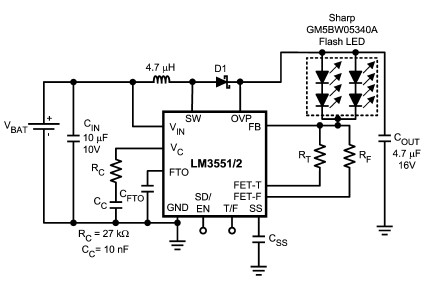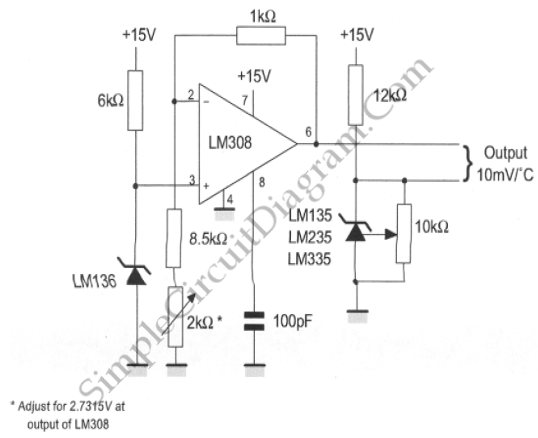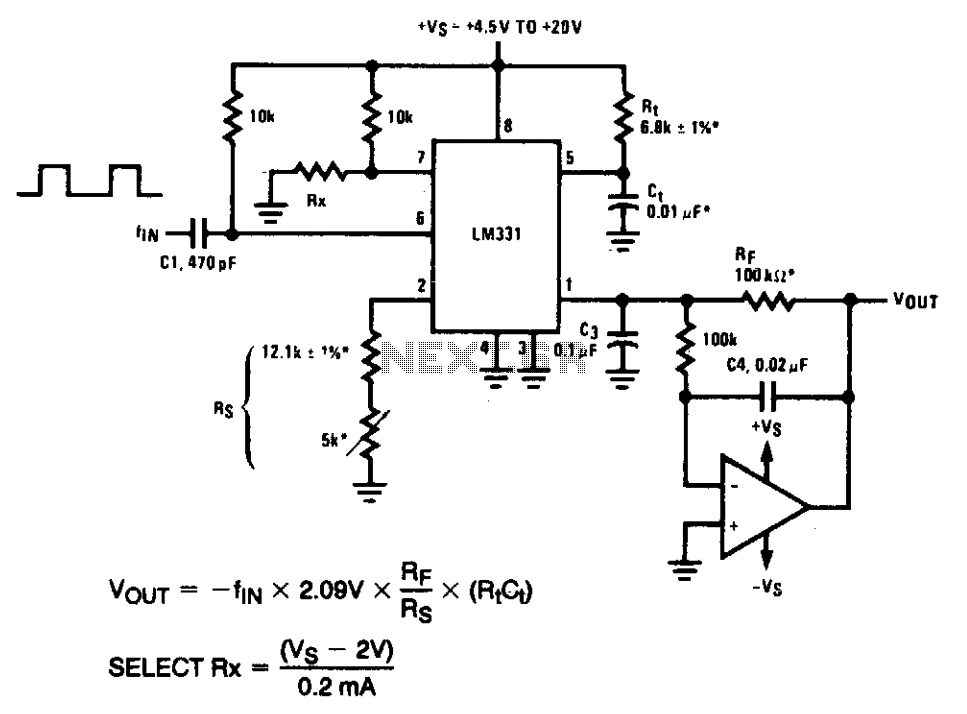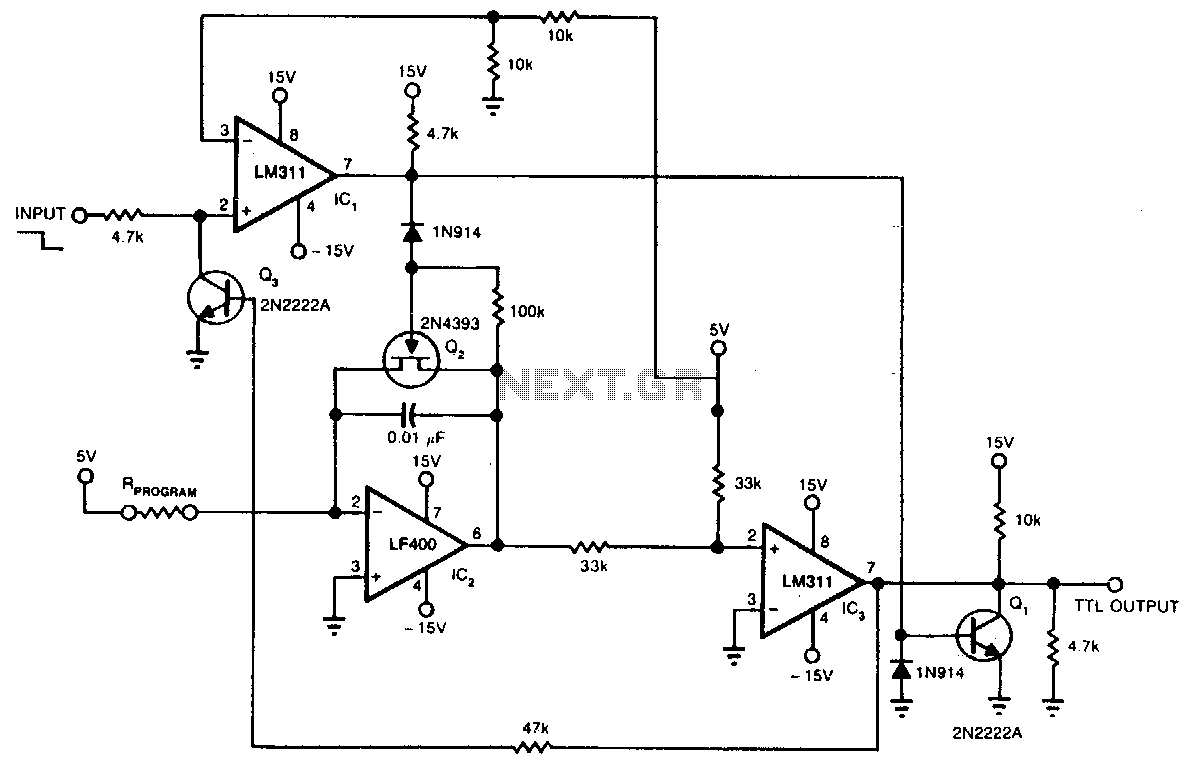
lm35 for precision centigrade
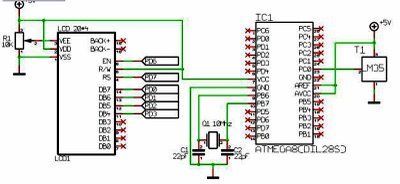
The LM35 series used in this project is a precision centigrade temperature sensor with an analog output voltage. It has a temperature range of -55 °C to +150 °C and an accuracy of ±0.5 °C. The output voltage is 10 mV/°C. This output voltage is converted by the ADC of the ATmega8 microcontroller, and the temperature is displayed on an LCD module. In this example, the thermometer operates within a range of 0 °C to 40 °C with a resolution of 0.5 °C. For Fahrenheit readings, the LM34 can be utilized. The BASCOM AVR compiler includes built-in commands to read the ADC port of an AVR microcontroller. The temperature result is displayed on an LCD module as a discrete value and in a bar graph format. The ATmega8 features an A/D converter capable of providing 210 = 1024 discrete values. When powered by a 5V supply, the resolution is calculated as 5000 mV/1024 = 4.8 mV. Given that the LM35 outputs 10 mV/°C, the thermometer's resolution approximates to 10 mV/4.8 mV, which is about 0.5 °C. The LCD module consists of 20 columns, where each column represents 2 °C within the 0 °C to 40 °C scale. The LM35 can be easily applied like other integrated-circuit temperature sensors; it can be adhered to a surface, and its temperature will be within approximately 0.01 °C of the surface temperature. This assumes that the ambient air temperature is similar to the surface temperature; if there is a significant temperature difference, the actual temperature of the LM35 die will be intermediate between the surface and air temperatures. This is particularly relevant for the TO-92 plastic package, where the copper leads primarily transfer heat into the device, potentially making its temperature closer to the air temperature. To mitigate this issue, wiring from the LM35 should be maintained at the same temperature as the surface of interest. A practical method is to cover these wires with epoxy to ensure that both the leads and wires maintain the same temperature as the surface, preventing air temperature from affecting the LM35 die's temperature. The TO-46 metal package can also be soldered to a metal surface or pipe without damage, grounding the V+ terminal to that metal. Alternatively, the LM35 can be enclosed in a sealed-end metal tube, allowing it to be immersed in a bath or installed in a threaded hole in a tank. As with any integrated circuit, the LM35 and its associated wiring and circuits must remain insulated and dry to prevent leakage and corrosion, especially in cold environments where condensation may form. Moisture-proof coatings and varnishes such as Humiseal and epoxy paints are frequently employed to protect the LM35 and its connections. These devices may also be soldered to a lightweight heat sink to reduce the thermal time constant and enhance response times in slowly moving air. Conversely, a small thermal mass could be added to the sensor to provide stable readings despite minor fluctuations in air temperature.
The LM35 temperature sensor is characterized by its linear output, making it straightforward to interface with microcontrollers. The sensor's output voltage increases linearly with temperature, allowing for easy calibration and scaling in software. The ATmega8 microcontroller, with its integrated ADC, effectively converts the analog voltage from the LM35 into a digital value, which can be processed and displayed on an LCD. The choice of the BASCOM AVR compiler facilitates the development process, providing efficient commands for ADC reading and display management.
The LCD module, capable of displaying both numerical values and graphical representations, enhances user interaction. The discrete values allow for precise temperature readings, while the bar graph provides a quick visual reference for temperature changes. The design considerations for the sensor's mounting and insulation are crucial for maintaining accuracy and reliability, especially in varying environmental conditions. Proper thermal management, through the use of epoxy or thermal mass, can significantly enhance the sensor's performance, ensuring rapid and accurate temperature readings.
In summary, the integration of the LM35 temperature sensor with the ATmega8 microcontroller and LCD display creates a versatile thermometer system suitable for a range of applications, from simple temperature monitoring to more complex environmental sensing. The careful consideration of sensor placement, insulation, and thermal response will contribute to the overall effectiveness and reliability of the temperature measurement system.The LM35 series that is used in this project is a precision centigrade temperature sensor, which has an analog output voltage. It has a range of -55 C to +150 C and an accuracy of ±0. 5 C. The output voltage is 10mV/ C. The output voltage is converted by the AD convertor of the AT Mega8. The temperature is displayed on an LCD module. In this e xample the thermometer has a range of 0 C to 40 C and a resolution of 0. 5 C. If you want to have a read out in Fahrenheit you can use the LM34. The BASCOM AVR compiler has build in commands for reading out the ADC port of an AVR microcontroller. The result is displayed on a LCD module in a discrete value of the temperature and in a bar-graph. The AT Mega8 has a A/D converter which can give an output of 210 = 1024 discrete values. When a 5V supply is used you have a resolution of 5000mV/1024 = 4. 8mV. Because the LM35 has an output of 10mV/C the resolution of the thermometer is 10mV/4. 8mV ~ 0. 5 C. The LCD module has 20 columns. In the scale of 0 C to 40 C every column represents 2 C. The LM35 can be applied easily in the same way as other integrated-circuit temperature sensors. It can be glued or cemented to a surface and its temperature will be within about 0. 01 °C of the surface temperature. This presumes that the ambient air temperature is almost the same as the surface temperature; if the air temperature were much higher or lower than the surface temperature, the actual temperature of the LM35 die would be at an intermediate temperature between the surface temperature and the air temperature.
This is especially true for the TO-92 plastic package, where the copper leads are the principal thermal path to carry heat into the device, so its temperature might be closer to the air temperature than to the surface temperature. To minimize this problem, be sure that the wiring to the LM35, as it leaves the device, is held at the same temperature as the surface of interest.
The easiest way to do this is to cover up these wires with a bead of epoxy which will insure that the leads and wires are all at the same temperature as the surface, and that the LM35 die`s temperature will not be affected by the air temperature. The TO-46 metal package can also be soldered to a metal surface or pipe without damage. Of course, in that case the V ’ terminal of the circuit will be grounded to that metal. Alternatively, the LM35 can be mounted inside a sealed-end metal tube, and can then be dipped into a bath or screwed into a threaded hole in a tank.
As with any IC, the LM35 and accompanying wiring and circuits must be kept insulated and dry, to avoid leakage and corrosion. This is especially true if the circuit may operate at cold temperatures where condensation can occur.
Printed-circuit coatings and varnishes such as Humiseal and epoxy paints or dips are often used to insure that moisture cannot corrode the LM35 or its connections. These devices are sometimes soldered to a small light-weight heat fin, to decrease the thermal time constant and speed up the response in slowly-moving air.
On the other hand, a small thermal mass may be added to the sensor, to give the steadiest reading despite small deviations in the air temperature. 🔗 External reference
The LM35 temperature sensor is characterized by its linear output, making it straightforward to interface with microcontrollers. The sensor's output voltage increases linearly with temperature, allowing for easy calibration and scaling in software. The ATmega8 microcontroller, with its integrated ADC, effectively converts the analog voltage from the LM35 into a digital value, which can be processed and displayed on an LCD. The choice of the BASCOM AVR compiler facilitates the development process, providing efficient commands for ADC reading and display management.
The LCD module, capable of displaying both numerical values and graphical representations, enhances user interaction. The discrete values allow for precise temperature readings, while the bar graph provides a quick visual reference for temperature changes. The design considerations for the sensor's mounting and insulation are crucial for maintaining accuracy and reliability, especially in varying environmental conditions. Proper thermal management, through the use of epoxy or thermal mass, can significantly enhance the sensor's performance, ensuring rapid and accurate temperature readings.
In summary, the integration of the LM35 temperature sensor with the ATmega8 microcontroller and LCD display creates a versatile thermometer system suitable for a range of applications, from simple temperature monitoring to more complex environmental sensing. The careful consideration of sensor placement, insulation, and thermal response will contribute to the overall effectiveness and reliability of the temperature measurement system.The LM35 series that is used in this project is a precision centigrade temperature sensor, which has an analog output voltage. It has a range of -55 C to +150 C and an accuracy of ±0. 5 C. The output voltage is 10mV/ C. The output voltage is converted by the AD convertor of the AT Mega8. The temperature is displayed on an LCD module. In this e xample the thermometer has a range of 0 C to 40 C and a resolution of 0. 5 C. If you want to have a read out in Fahrenheit you can use the LM34. The BASCOM AVR compiler has build in commands for reading out the ADC port of an AVR microcontroller. The result is displayed on a LCD module in a discrete value of the temperature and in a bar-graph. The AT Mega8 has a A/D converter which can give an output of 210 = 1024 discrete values. When a 5V supply is used you have a resolution of 5000mV/1024 = 4. 8mV. Because the LM35 has an output of 10mV/C the resolution of the thermometer is 10mV/4. 8mV ~ 0. 5 C. The LCD module has 20 columns. In the scale of 0 C to 40 C every column represents 2 C. The LM35 can be applied easily in the same way as other integrated-circuit temperature sensors. It can be glued or cemented to a surface and its temperature will be within about 0. 01 °C of the surface temperature. This presumes that the ambient air temperature is almost the same as the surface temperature; if the air temperature were much higher or lower than the surface temperature, the actual temperature of the LM35 die would be at an intermediate temperature between the surface temperature and the air temperature.
This is especially true for the TO-92 plastic package, where the copper leads are the principal thermal path to carry heat into the device, so its temperature might be closer to the air temperature than to the surface temperature. To minimize this problem, be sure that the wiring to the LM35, as it leaves the device, is held at the same temperature as the surface of interest.
The easiest way to do this is to cover up these wires with a bead of epoxy which will insure that the leads and wires are all at the same temperature as the surface, and that the LM35 die`s temperature will not be affected by the air temperature. The TO-46 metal package can also be soldered to a metal surface or pipe without damage. Of course, in that case the V ’ terminal of the circuit will be grounded to that metal. Alternatively, the LM35 can be mounted inside a sealed-end metal tube, and can then be dipped into a bath or screwed into a threaded hole in a tank.
As with any IC, the LM35 and accompanying wiring and circuits must be kept insulated and dry, to avoid leakage and corrosion. This is especially true if the circuit may operate at cold temperatures where condensation can occur.
Printed-circuit coatings and varnishes such as Humiseal and epoxy paints or dips are often used to insure that moisture cannot corrode the LM35 or its connections. These devices are sometimes soldered to a small light-weight heat fin, to decrease the thermal time constant and speed up the response in slowly-moving air.
On the other hand, a small thermal mass may be added to the sensor, to give the steadiest reading despite small deviations in the air temperature. 🔗 External reference
